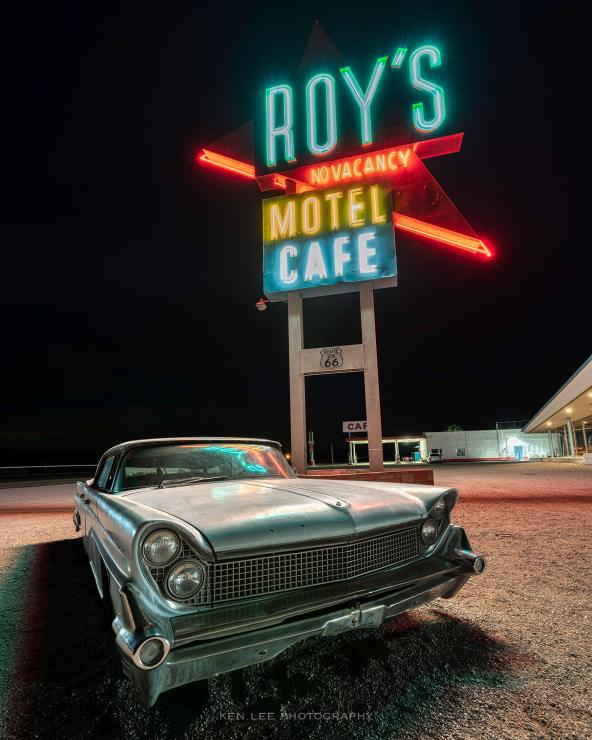I photographed this historic scene at night. This was very dynamic, a very dark sky coupled with the very bright neon sign. Additionally, there was a lot of shadow in the front of the car. I’ll describe how I got the photo.
I went on an 8-day, 1,856-mile night photography road trip with several friends. Along the way, we photographed part of historic Route 66. This included the iconic Roy’s Motel and Cafe neon sign at Amboy, CA.
This particular evening was supposed to have a nearly full moon, a waning gibbous with 93% illumination. However, the moon was nowhere to be seen, hiding behind some very thick clouds. This accounts for the inky black sky.

These are the three steps I took for getting the photo when I was at Amboy.
1. Positioning
I really wanted the sign in the photo along with the entire car. But I also wanted as much of the reflection of the neon sign in the front windshield as possible to evoke that historic feel.
2. Bracketing
First I took six photos in a row, bracketing them by changing the length of the exposure to be between about 2–6 seconds. I kept the other settings at f/11 and ISO 200. I chose f/11 so that the lights of the sign would create slight starbursts.
3. Light painting the car
I then took another photo. For this one, I ran over to the camera right and illuminated part of the front grille of the car. I used warm white light from a handheld ProtoMachines LED2 during the 5.3-second exposure. It’s very subtle, but it brings out some of the detail and texture of the front.
Post-processing
I used a Pentax K-1, which has a very wide dynamic range. In fact, I could have probably pulled off this photo by taking a single exposure and bringing up some of the shadows. However, I have Aurora HDR, which is a brilliant editor that makes it easy to get natural-looking photos, so I figured I would use that instead. It looked great with the default setting. I tweaked it a little more to bring out some further detail, and that was about it.
After that, I simply blended in the front grille of the car from the seventh photo, the one where I had light painted the front of the car. Done!
Tell your story with the second annual Visual Storytelling Conference!
Experience four days of interactive, online training sessions featuring a range of educational content with experienced photographers and content creators. This free event kicks off with a series of technical boot camps to build essential skills, followed by live, online sessions on photography, video, business and social media. Join live from March 10-13, 2022!
